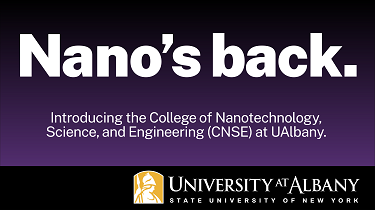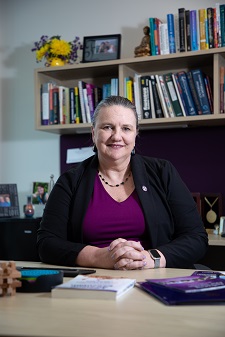UAlbany Launches College of Nanotechnology, Science & Engineering
ALBANY, N.Y. (Aug. 16, 2023) —The University at Albany today announced the creation of the College of Nanotechnology, Science, and Engineering, a newly expanded academic unit that strengthens UAlbany’s position as a leader in engineering, nanotechnology, semiconductor research, computer science and artificial intelligence.
The college is the product of a union between UAlbany’s College of Engineering and Applied Sciences (CEAS) and the former College of Nanoscale Science and Engineering (CNSE), which was founded at UAlbany two decades ago and spent the last nine years as the Albany campus of the Utica-based SUNY Polytechnic Institute.
The reunified CNSE will serve new and continuing students starting this week with the fall 2023 semester.
A Global Reputation for Innovation
The union preserves the original CNSE’s global reputation for excellence in nanotechnology and semiconductor research while embedding it within the formidable academic and research enterprises of a comprehensive public research university that is among the most diverse in the nation. UAlbany is one of SUNY’s four R1 University Centers, signifying the highest level of research and doctoral activity.
“Today is a historic day for UAlbany. The federal government is making unprecedented investments in domestic semiconductor research and development, and a reunified UAlbany and CNSE will ensure New York leads the pack in critical fields such as next-generation chip design,” UAlbany President Havidán Rodríguez said. “As one of the most diverse public research institutions in the nation, UAlbany also is uniquely positioned to help ensure the skilled workforce needed for this generational economic transformation reflects the rich diversity of our state. I am proud to welcome CNSE students, faculty and staff back to the UAlbany family, and I am incredibly excited about what the future holds for our university.

"The fact that we were able to complete this complex transition four months ahead of schedule is a testament to the hard work of the dedicated employees at UAlbany, SUNY Poly and SUNY who were committed to ensuring our students, faculty and staff were well served and could begin the fall semester with the reassurance of knowing the transition was complete," Rodríguez said.
Wednesday’s announcement marks the conclusion of eight months of close collaboration to transfer 10 academic programs and approximately 90 continuing students, 29 faculty and lecturers, and more than 100 post-docs, staff members and Research Foundation personnel back to UAlbany. It also marks a significant milestone toward the realization of Gov. Kathy Hochul’s ambitious vision to double SUNY’s external research funding and cement the system’s four research centers as national and global epicenters of innovation and discovery.
“For the researchers who will push the limits of science, for the students who have an unparalleled opportunity to study and enjoy experiential learning, for the industry partners who will thrive, and for the workers who will enjoy good-paying jobs, CNSE continues to unlock new synergies and new opportunities," said John B. King Jr., chancellor of the State University of New York. "The commitment to high-technology advancement in this region is strong, and I have no doubt it will bear extraordinary fruit in the coming years and decades.”
Helping the U.S. Lead in Semiconductors
The SUNY Board of Trustees voted in December to begin the reunification, noting the “vibrant research and education opportunities of an R1 SUNY University Center like UAlbany” and, hand in hand with a strengthened SUNY Poly, the importance of greater regional and statewide coordination of nanotechnology research and economic development.
Researchers at the two institutions already have a long and successful record of collaboration, including through UAlbany’s Ion Beam Lab and RNA Institute, which was recently jointly awarded nearly $460,000 with the former CNSE to study how RNA modifications impact cancer development and aging.
With the federal government poised to invest $52 billion in the domestic semiconductor industry through the CHIPS and Science Act championed by U.S. Sen. Chuck Schumer, the reunification paves the way for new interdisciplinary research partnerships and significant new opportunities for federal funding.
“Strategic academic partnerships will be critical to realizing the federal government’s goal to make the United States the unchallenged leader in global semiconductor research, development and production,” said UAlbany Vice President for Research and Economic Development Thenkurussi “Kesh” Kesavadas. “UAlbany and CNSE have the expertise, track record and infrastructure to collaborate with industry leaders on the exchange of ideas and knowledge that is the lifeblood of scientific discovery and technological innovation. These partnerships, for which CNSE and Albany NanoTech are already well known, make the University at Albany an essential component of Gov. Hochul’s vision to fully harness SUNY’s research prowess to drive private investment and economic development across New York.”
The academic programs that have returned to UAlbany include:
Undergraduate
- BS Nanoscale Science
- BS Nanoscale Engineering
- Minor in Nanotechnolgy
Graduate
- MS Nanoscale Science
- MS Nanoscale Engineering
- MS Nanobioscience
- PhD Nanoscale Science
- PhD Nanoscale Engineering
- PhD Nanobioscience
- MD/PhD in Medicine and Nanoscale Science or Engineering
Seeding New Scholarly Collaborations
The newly created Department of Nanoscale Science & Engineering joins UAlbany’s existing strengths in the departments of Computer Science, Electrical & Computer Engineering, and Environmental & Sustainable Engineering as part of the reunified CNSE.

The new CNSE will be led by Dean Michele Grimm, who previously served as dean of UAlbany’s College of Engineering and Applied Sciences. Professor J. Andres Melendez, a widely published expert in nanobioscience who served as interim dean of CNSE at SUNY Poly, will continue his teaching and research as an integral part of CNSE’s faculty and has agreed to become chair of the new department.
“The new CNSE will be an academic powerhouse, and we are very grateful to Dean Grimm and Dr. Melendez, whose leadership has been pivotal during the reunification process,” said UAlbany Provost and Senior Vice President for Academic Affairs Carol Kim. “Dean Grimm’s talents are well known to us, and we are thrilled to be working with Dr. Melendez, a gifted scientist whose insight and leadership will help continue to ensure a smooth transition as these two incredible groups of educators and scientific researchers join forces.”
Earlier this summer, the New York State Department of Education and the institutions’ accreditor, the Middle States Commission on Higher Education, signed off on the program transfers. ABET, the accreditor of engineering programs on both campuses, also approved.
A Shared History of Excellence
The original CNSE was founded at UAlbany in 2004 and played an integral role in the growth of the Albany Nanotech Complex on Fuller Road into an international hub of cutting-edge semiconductor research and development. In 2014, SUNY merged CNSE with Utica-based SUNY IT to create SUNY Polytechnic Institute. Despite the change, CNSE’s academic and research programs remained in Albany, and even after the separation UAlbany continued to offer services such as housing, recreational programming and medical care to CNSE students.
Faculty and researchers in the reunified CNSE will continue to occupy some space in the Albany NanoTech Complex across Fuller Road from UAlbany’s Uptown Campus. Meanwhile, the renovation of the former Albany High School on the Downtown Campus continues, with some CNSE academic units beginning to relocate downtown in the new year, led by the Department of Electrical & Computer Engineering and the dean’s office.
“The faculty and students in our reunified college are poised to expand their research and educational leadership by building on our historic strengths while using a multidisciplinary approach to tackle challenging societal problems,” CNSE Dean Michele Grimm said. “Whether looking at improved semiconductor manufacturing processes focused on sustainability, more efficient chip design using AI, or the ability to advance computer hardware design at the nano and macro level, each of the original CEAS departments – in Computer Science, Electrical & Computer Engineering, and Environmental & Sustainable Engineering – has identified opportunities to collaborate with Nanoscale Science & Engineering. Together, the new CNSE will pursue a convergent research and design framework to address the needs of individuals, companies, our nation and our world.”
CNSE and AI Plus
CNSE’s return to UAlbany comes as the University is undertaking its largest cluster hire in history, which will bring 27 new faculty members specializing in artificial intelligence to eight schools and colleges as part of the AI Plus initiative.
AI Plus is UAlbany’s holistic approach to integrating teaching and learning about AI across the University’s academic and research programs to ensure every graduate is prepared to live and work in a world radically changed by technology in the coming decades. The new hires will include a new director of the AI Plus institute, a hub for interdisciplinary AI research involving faculty from across campus.
As part of AI Plus, UAlbany is building powerful new supercomputing clusters that will enable researchers from CNSE and beyond to push the frontiers of next-generation microchip design as well as other semiconductor applications that will help seed new industry partnerships and drive economic growth.
U.S. Rep. Paul Tonko said, “As SUNY continues to serve as an important partner in our efforts to bring new high-tech jobs and economic and social opportunity to all New Yorkers, I’m thrilled to join in celebrating the reunification of UAlbany and CNSE. This move will only further enhance SUNY’s status as a national leader in cutting-edge research, opening new avenues for expanded funding and partnerships with both the public and private sectors. Since the passage of the CHIPS and Science Act last year, which I proudly supported, I’ve been working tirelessly to ensure that our Capital Region reaps the benefits of this transformative legislation in the form of new skilled manufacturing jobs and economic growth in communities across our district. With this exciting news, I’m confident that our Capital Region, New York State, and our nation will continue to compete vigorously in our global economy.”
State Sen. Neil Breslin said, “CNSE’s groundbreaking work in the area of nanotechnology and semiconductor science will dovetail beautifully with UAlbany’s current research in life sciences, bioscience, bioengineering, and climate science, and the University's forthcoming plans to incorporate its AI Plus curriculum across all disciplines. This forward-thinking, full-court press approach to research and academics will help further UAlbany’s status as one of the nation’s leading public research universities and spark a spirit of innovation, creativity and collaboration that will attract outstanding talent and millions of additional research dollars to the region and state.”
Assemblymember Pat Fahy said, “The reuniting of these two extraordinary educational institutions is a truly transformational opportunity for the Capital Region and Upstate. I am excited — and ready — to work with the University and its partners, and my colleagues in the legislature, to grow and nurture nanotechnology and semiconductor research in New York. Reunification will bring about the development of curricular approaches and experiential learning opportunities designed to prepare UAlbany students to thrive in a 21st century workforce and it will give rise to groundbreaking partnerships that yield lifechanging advances in environmental science, public health, engineering and technology. Upstate New York is well on its way to becoming a research powerhouse.”
Mark Eagan, president and CEO of the Capital Region Chamber and Center for Economic Growth, said, “With the reunification of the University at Albany and CNSE, UAlbany students will have access to new and innovative academic programs and exciting next-generation interdisciplinary research, as well as many more meaningful opportunities to interact with and learn from business and industry partners throughout the Capital Region. We expect to see greater enrollment at UAlbany due to these expanded academic offerings and professional opportunities. This means more dollars and jobs for our regional economy and, ultimately, a better prepared and more skilled workforce for area employers.”




